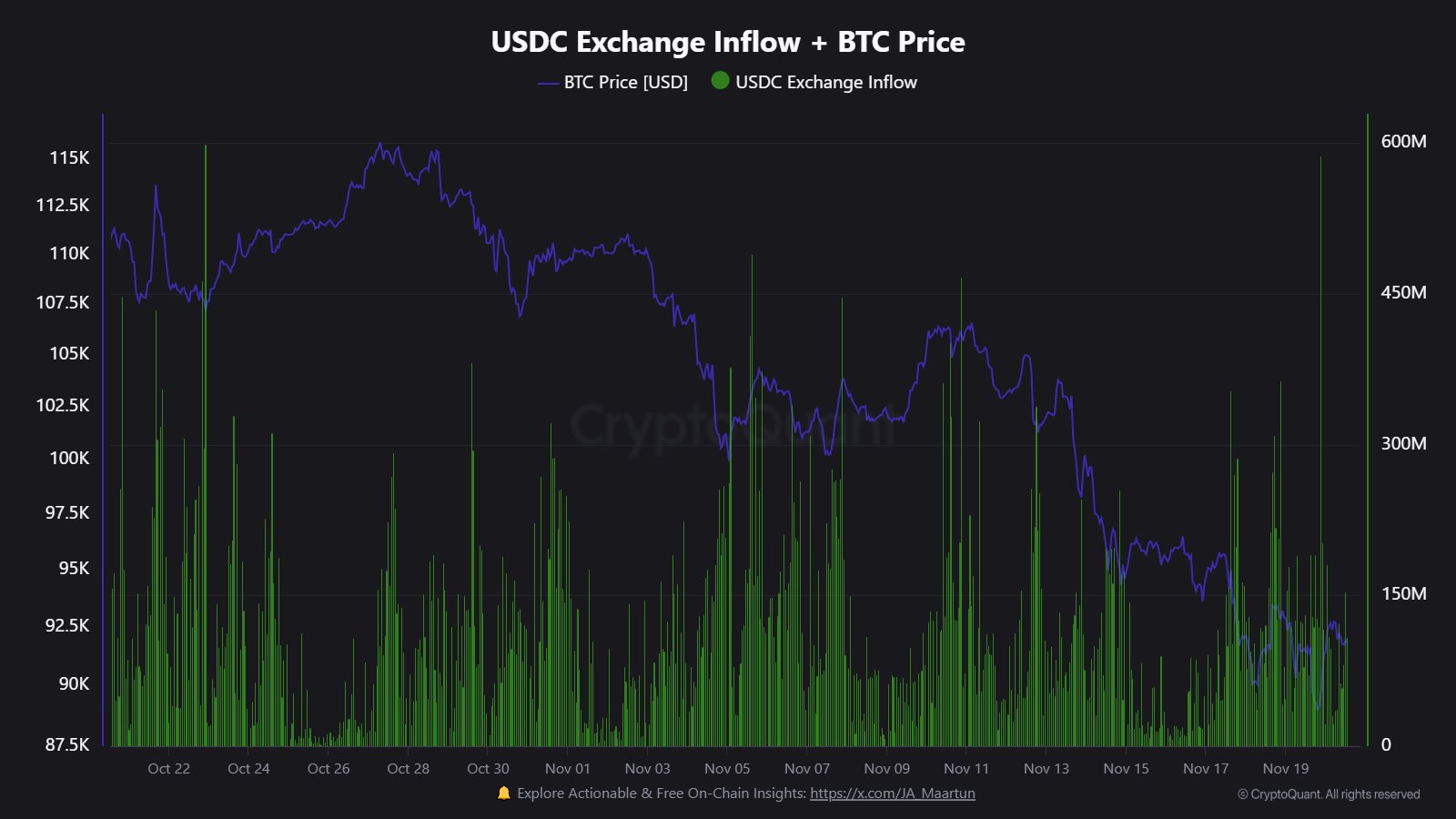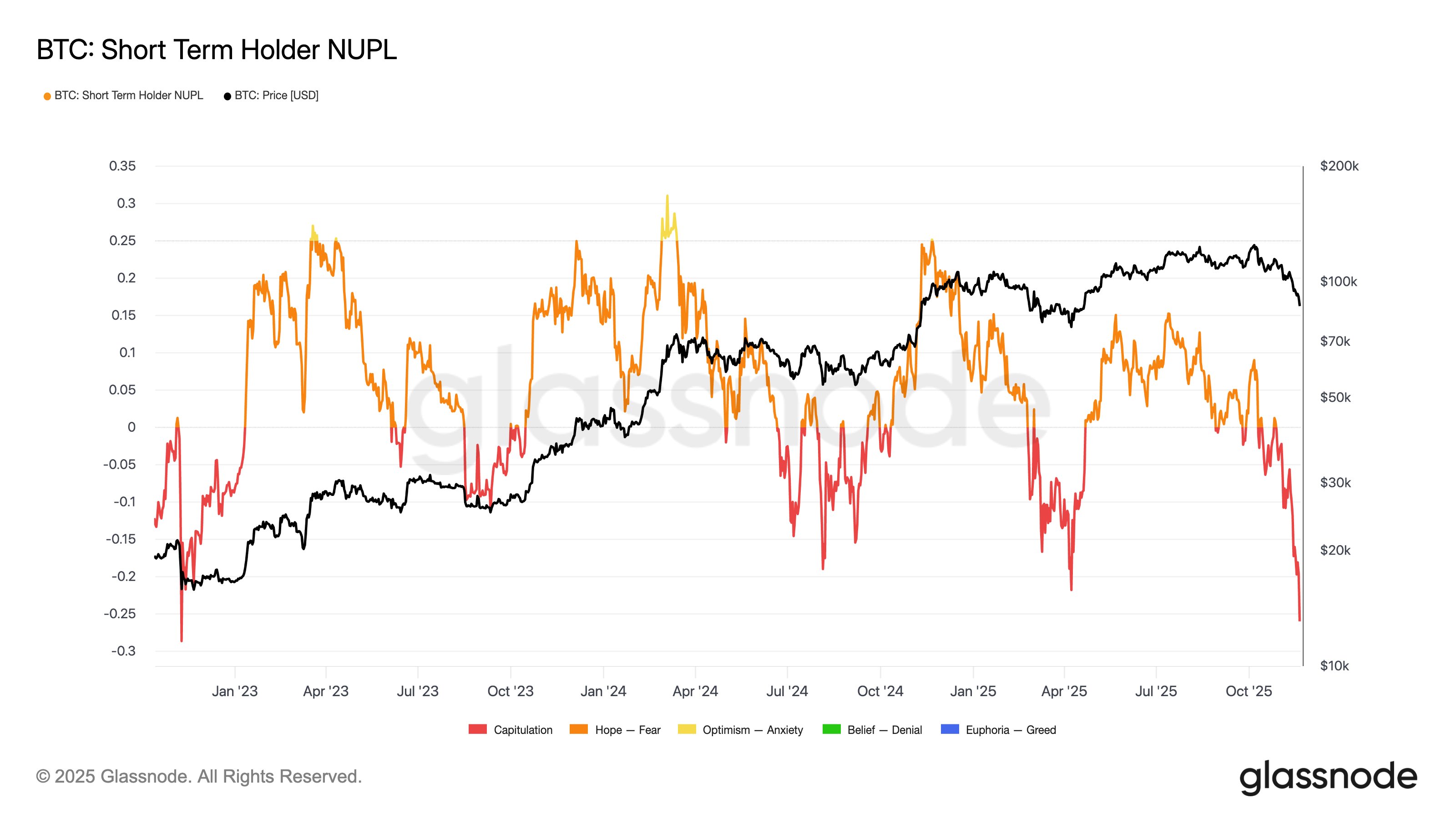In the shadowed corridors of on-chain data, a curious dance unfolds: USDC, the unassuming stablecoin, surges onto exchanges like a scribe clutching ink-stained scrolls. One might wonder, do these inflows herald a desperate bid to purchase Bitcoin’s shattered remains? Or is it merely the echo of traders whispering, “Patience, dear chaos, we shall return when you least expect it”? 😂
The Mysterious March of USDC
CryptoQuant’s Maartunn, a prophet of spreadsheets, has observed a crescendo in USDC’s exchange inflows. This “inflow,” as he terms it, is the ledger’s way of sighing as capital migrates to centralized strongholds. Why? Because when investors deposit their coins, it is often to trade them away-a ritual as old as markets themselves. Yet, what does this portend for Bitcoin, that volatile phoenix? A bearish omen? Perhaps. Or a prelude to resurrection?
Stablecoins, those paragons of calm, remain untouched by the tempest. Pegged to fiat, they drift serenely while Bitcoin flails. Yet, their inflows are no mere spectator sport. Traders, weary of the wild, hoard stables like fortresses. But when the hour strikes, they send their capital forth to reclaim the spoils of volatility. Thus, these inflows may yet be the harbinger of a bullish dawn. 🚀

And what of Bitcoin’s recent plunge? A crash, yes, but one met with the kind of enthusiasm only a bear market could inspire. Traders, like scavengers in a post-apocalyptic world, whisper, “Buy the dip!”-a mantra as hollow as a winter moon. Meanwhile, short-term holders (STHs) wade through a sea of red, their Net Unrealized Profit/Loss chart resembling a funeral shroud. Chris Beamish, the Glassnode oracle, notes their plight: “STHs are seriously feeling the pain.” A poetic justice for those who dared to time the market. 😢

BTC Price: A Rollercoaster of Emotions
Bitcoin, that mercurial beast, dipped below $81,000 before clawing its way back to $83,900. A rebound? A mirage? The chart, a Rorschach test for optimists and pessimists alike, leaves us to ponder: Is this a phoenix rising, or a gambler’s last bet? 🎲

tags or color styles. Also, a clickbait title under 100 characters in a
tag is needed, with humor, sarcasm, and emojis. The title shouldn’t be repeated as a header in the body. I need to make sure the title is catchy but fits Solzhenitsyn’s style-though that’s a bit conflicting. Maybe use metaphors related to his works, like “Gulag” or “rebellion,” but add some humor with emojis.</p>
<p>The original text is about USDC inflows to exchanges and Bitcoin’s price dip. To adapt this into Solzhenitsyn’s style, I should use more metaphorical language. Instead of stating facts bluntly, perhaps compare the market’s movements to struggles against oppressive forces. Use terms like “the silent majority of capital” or “the beast of volatility.” Also, inject sarcasm where possible, maybe in the analysis of traders’ actions, likening them to prisoners in a camp trying to find hope.</p>
<p>I need to ensure that the HTML structure is correct. The title tag is separate, and the body uses </p>
<p> and </p>
<h2> tags as in the original. The images should remain with their classes and sources. Avoid any markdown, just plain HTML. Check for the absence of tags and color styles.</p>
<p>Humor and sarcasm can be subtle. Maybe refer to “the sacred cow of fiat-backed stables” with a hint of irony. Emojis should be used sparingly but effectively, perhaps at the end of the title or in the body to add a touch of dark humor. For example, a 🐻 (bear) emoji for the bear market or 🚀 for the potential bullish sign.</p>
<p>Also, the user mentioned not repeating the title in the body as a header. So the </p>
<h2> tags should remain as in the original, but the main title is only in the <title> tag. Make sure the title is concise and under 100 characters. Maybe something like “USDC Inflows: A Bear Market Ballet 🐻💸”?</p>
<p>Now, rewriting the content. Start with a metaphor about the market’s turmoil, using Solzhenitsyn’s introspective style. Replace technical terms with more poetic language. For example, instead of “on-chain data shows,” say “the silent numbers whisper…” Use phrases that evoke a sense of inevitability or struggle. </p>
<p>In the part about USDC inflows being bullish, contrast the usual bearish interpretation with a more nuanced view, perhaps likening it to a glimmer of hope in dark times. For the STHs’ pain, compare it to the suffering in his novels, highlighting the human element. </p>
<p>Check for the emojis and humor. Maybe add a 🐻 for the bear market, a 🚀 for bullish signs, and a 😂 for the sarcastic remarks. Ensure they don’t clash with the serious tone but add a layer of irony.</p>
<p>Finally, verify that all HTML tags are correctly closed and the structure mirrors the original. No markdown, just HTML. Ensure the title is under 100 characters and includes emojis. Avoid any explanations or extra text in the title. Make sure the body text reflects Solzhenitsyn’s style with the required elements.End of Thought (30.59s)<br />
<title>USDC Inflows: A Bear Market Ballet 🐻💸
Read More
2025-11-22 09:07


